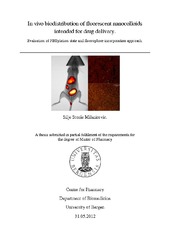| dc.description.abstract | To move the use of PLGA nanocolloids from laboratories towards the use in humans require careful investigations around pharmacokinetics and biodistributions. The biodistributions of the nanocolloids can be traced through NIR in vivo imaging in a non-invasive manner. In the present study the biodistributions of two types of PLGA nanocolloids were compared, nanocapsules with an oily core loaded with carbocyanine dyes and solid nanoparticles with the fluorescent dye covalently linked. The nanocolloids were produced by nanoprecipitation; all were of injectable sizes, showed monodispersity and negative zeta potentials. The biodistributions of DiD dye loaded nanocapsules with an oily core and solid nanoparticles conjugated to the dye DY-700 were injected in mice, and followed over 24 hours through NIR imaging, before organs were collected and imaged. Bone marrow was also collected. Solid nanoparticles were also made with a polymer covalently linked to rhodamine. After 24 hours the organs were collected for further ex vivo analysis by confocal microscopy. The nanocolloids seemed to accumulate mainly in the liver, spleen and the intestine. The accumulation developed differently, and the PEGylated nanocarriers showed indications of longer circulation times, and lower accumulation in the liver. The oily core nanocapsules showed fluorescence accumulation in the bones, which was not seen with the solid nanocapsules. This was confirmed by quantification of fluorescence in collected bone marrow. This, together with accumulation in the intestine and fluorescence lifetime investigations suggested that DiD loaded nanocapsules release some dye. In line with this nanocolloids with the fluorescent dye covalently linked did not accumulate in the bone marrow, and to a small degree in the intestine. The ex vivo investigations were in concurrence with the results seen in vivo. PEGylated nanoparticles dominated in the spleen and brown adipose tissue whereas unPEGylated nanoparticles dominated in the liver and lungs. Taken together, this study give insight in the biodistributions of nanocolloids intended for incorporation of chemotherapeutics, and also one has to be careful when choosing fluorescence labelling approach for in vivo detection of nanoparticles. | en_US |
